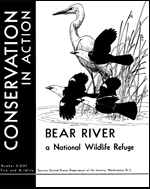United States Fish and Wildlife Service

United States Fish and Wildlife Service: Publications
Date of this Version
7-24-2008
Citation
U.S. Fish and Wildlife Service. 2008. Waterfowl population status, 2008. U.S. Department of the Interior, Washington, D.C. USA.
Abstract
In the Waterfowl Breeding Population and Habitat Survey traditional survey area (strata 1‒18, 20‒50, and 75‒77), the total duck population estimate was 37.3 ± 0.6 [SE] million birds. This was 9% lower than last year's estimate of 41.2 ± 0.7 million birds, but 11% above the 1955-2007 long-term average. Mallard (Anas platyrhynchos) abundance was 7.7 ± 0.3 million birds, similar to last year's estimate of 8.3 ± 0.3 million birds and to the long-term average. Blue-winged teal (A. discors) estimated abundance was 6.6 ± 0.3 million birds similar to last year's estimate of 6.7 ± 0.4 million birds, and 45% above the long-term average. Estimated abundances of gadwall (A. strepera; 2.7 ± 0.2 million) and northern shovelers (A. clypeata; 3.5 ± 0.2 million) were lower than those of last year (‒19% and ‒23%, respectively), but both remained 56% above their long-term averages. Estimated abundance of American wigeon (A. americana; 2.5 ± 0.2 million) was similar to the 2007 estimate and the long-term average. Estimated abundances of green-winged teal (A. crecca; 3.0 ± 0.2 million) and redheads (Aythya americana; 1.1 ± 0.1 million) were similar to last year's, but were each >50% above their long-term averages. The redhead and green-winged teal estimates were the highest and the second highest ever for the traditional survey area. The canvasback (A. valisineria) estimate of 0.5 ± 0.05 million was down 44% relative to 2007's record high, and 14% below the long-term average. Northern pintails (Anas acuta; 2.6 ± 0.1 million) were 22% below last year's estimate and 36% below their long-term average. The scaup (Aythya anis and A. marila combined; 3.7 ± 0.2 million) estimate was similar to that of 2007, and remained 27% below the long-term average. Habitat conditions during the 2008 Waterfowl Breeding Population and Habitat Survey were characterized in many areas by a delayed spring compared to several preceding years. Drought in many parts of the traditional survey area contrasted sharply with record snow and rainfall in the eastern survey area. The total pond estimate (Prairie Canada and U.S. combined) was 4.4 ± 0.2 million ponds, 37% below last year's estimate of 7.0 ± 0.3 million ponds and 10% lower than the long-term average of 4.9 ± 0.03 million ponds. The 2008 estimate of ponds in Prairie Canada was 3.1 ± 0.1 million. This was a 39% decrease from last year's estimate (5.0 ± 0.3 million), and 11% below the 1955-2007 average (3.4 ± 0.03 million). The 2008 pond estimate for the north-central U.S. (1.4 ± 0.1 million) was 30% lower than last year's estimate (2.0 ± 0.1 million) and 11% below the long-term average (1.5 ± 0.02 million). The projected mallard fall-flight index was 9.2 ± 0.8 million, similar to the 2007 estimate of 10.9 ± 1.0 million birds. The eastern survey area was restratified in 2005 and is now composed of strata 51-72. Estimates of mallards, scaup, scoters (black [Melanitta nigra], white-winged [M. fusca], and surf [M. perspicillata]), green-winged teal, American wigeon, buehead (B. albeola), American black duck (A. rubripes), ring-necked duck (Aythya collaris), mergansers (red-breasted [Mergus serrator], common [M. merganser], and hooded [Lophodytes cucullatus]), and goldeneye (common [Bucephala clangula] and Barrow's [B. islandica]) all were similar to their 2007 estimates and long-term averages.

